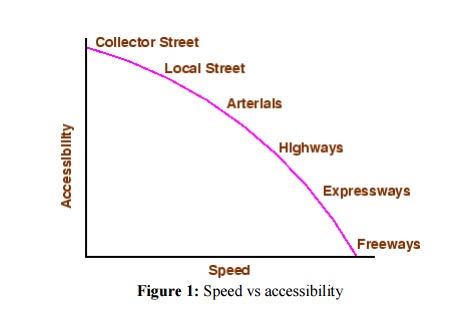Chapter: Civil : Highway Engineering
Road classification

Road classification
The roads can be
classified in many ways. The classification based on speed and accessibility is
the most generic one. Note that as the accessibility of road increases, the
speed reduces. (See figure . Accordingly, the roads can be
classified as follows in the order of increased accessibility and reduced
speeds.
·
Freeways: Freeways are access-controlled
divided highways. Most freeways are four lanes, two lanes each direction, but
many freeways widen to incorporate more lanes as they enter urban areas. Access
is controlled through the use of interchanges, and the type of interchange
depends upon the kind of intersecting road way (rural roads, another freeway
etc.)
·
Expressways: They are superior type of
highways and are designed for high speeds ( 120 km/hr is common), high traffic
volume and safety. They are generally provided with grade separations at
intersections. Parking, loading and unloading of goods and pedestrian traffic
is not allowed on expressways.
·
Highways: They represent the superior
type of roads in the country. Highways are of two types - rural highways and
urban highways. Rural highways are those passing through rural areas (villages)
and urban highways are those passing through large cities and towns, ie. urban
areas.
·
Arterials: It is a general term denoting
a street primarily meant for through traffic usually on a continuous route.
They are generally divided highways with fully or partially controlled access.
Parking, loading and unloading activities are usually restricted and regulated.
Pedestrians are allowed to cross only at intersections/designated pedestrian
crossings.
·
Local streets : A local street is the
one which is primarily intended for access to residence, business or abutting
property. It does not normally carry large volume of traffic and also it allows
unrestricted parking and pedestrian movements.
· Collector streets: These are streets intended for collecting and distributing traffic to and from local streets and also for providing access to arterial streets. Normally full access is provided on these streets . There are few parking restrictions except during peak hours.
Related Topics